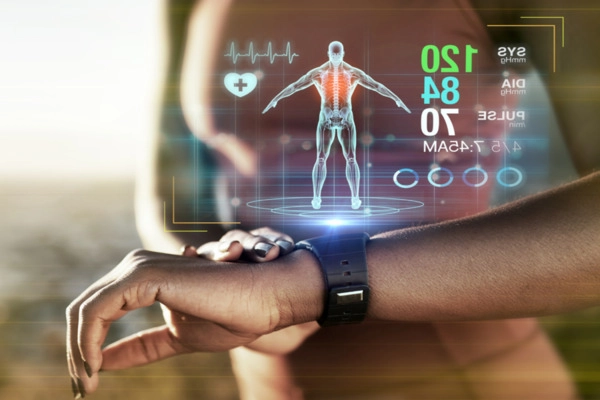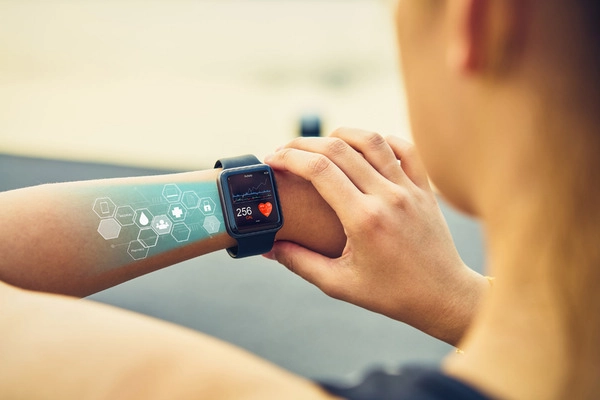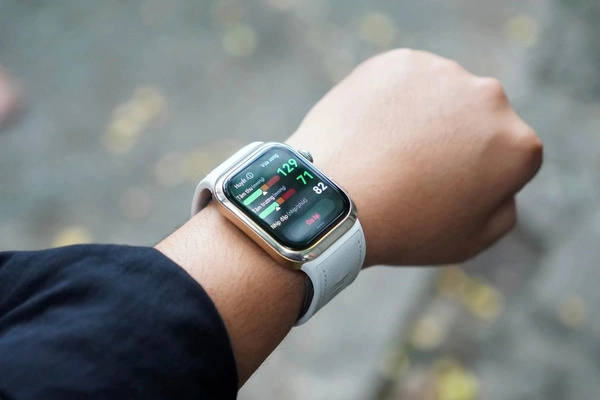In the era of Industry 4.0, wearable IoT devices are emerging as a prominent trend, connecting people with intelligent data. From watches and fitness bands to smart clothing and glasses, these devices not only monitor health and physical activity but also enhance everyday life experiences. This article explores how wearable IoT devices work, their benefits, applications, and the challenges of this smart wearable technology.
What are wearable IoT devices?
In the digital age, wearable IoT devices have become a leading trend, enabling smart connectivity between people and electronic devices. So, what exactly are wearable IoT devices? They are devices designed to be worn directly on the body—ranging from watches and fitness bands to smart clothing and glasses – with the ability to collect data, connect to the Internet, and interact with various applications.

Unlike traditional electronic devices, wearable IoT devices provide real-time information, allowing users to monitor their health, physical activity, sleep, and even receive alerts for potential health risks. They not only support personal well-being but also expand opportunities for research and big data analysis in healthcare, sports, and other fields. This trend is gradually becoming an essential part of modern life, helping people better manage daily habits and overall health.
How wearable IoT devices work
Wearable IoT devices operate based on smart connectivity and data collection principles. Each device is typically equipped with small sensors, processing chips, and wireless connections to capture body metrics, environmental data, or user activities. Once the data is collected, it is transmitted via Bluetooth, Wi-Fi, or mobile networks to smartphones, computers, or cloud platforms, where it is analyzed and presented in an easily understandable format.

The operation of these devices can be summarized in three steps: data collection, data transmission, and information processing. Through this process, users receive detailed reports on heart rate, blood pressure, step count, sleep patterns, and activity levels. Furthermore, some devices use artificial intelligence (AI) to predict health trends and provide recommendations for improving lifestyle habits. This is why wearable IoT devices are becoming increasingly popular in modern life.
Benefits of using wearable IoT devices
Using wearable IoT devices offers numerous important benefits, ranging from health monitoring to optimizing daily life:

- Continuous health monitoring: Users can track their heart rate, blood pressure, calorie consumption, and other health indicators without needing to visit a medical facility.
- Improved physical performance: With detailed measurement data, users can easily plan workouts, monitor progress, and achieve their fitness goals.
- Sleep monitoring: Wearable IoT devices can analyze sleep patterns, helping users adjust their habits to improve rest quality.
- Enhanced convenience: These devices can sync notifications from smartphones, remind users of schedules, and even control smart home devices.
Thanks to their connectivity and data analysis capabilities, users can proactively manage their health, improve lifestyle habits, and boost productivity. These benefits make wearable IoT devices indispensable tools in modern life.
Popular applications of wearable IoT devices
Today, wearable IoT devices come in various forms and serve multiple purposes, from health and fitness to entertainment and work. Some of the most common applications include:
Smartwatches
Smartwatches are the most popular devices in the wearable IoT category. Beyond telling time, they track heart rate, steps, calorie consumption, and sleep. Advanced models can also monitor blood pressure and blood oxygen levels, providing timely health alerts. Smartwatches allow users to manage their health while conveniently receiving phone notifications, and they often include features such as calling, messaging, music control, and GPS navigation.

Fitness Trackers
Smart wristbands, or fitness trackers, primarily focus on monitoring physical activity. They record steps taken, distance traveled, activity levels, calories burned, and sleep patterns. The data from these wristbands is synced to mobile applications, allowing users to track their workout progress, set health goals, and improve daily habits. This makes them an ideal tool for anyone looking to maintain an active and healthy lifestyle.

Smart Clothing and Glasses
Wearable IoT technology extends beyond watches and wristbands to include smart clothing and glasses. Clothing embedded with sensors can monitor heart rate, body temperature, and sweat levels, making it highly useful for athletes and fitness enthusiasts. Smart glasses provide augmented reality (AR) experiences, supporting navigation, learning, and remote work. These devices demonstrate that wearable technology not only serves health purposes but also delivers enhanced digital convenience and entertainment experiences.

Security and Privacy Issues in Wearable IoT Devices
Although wearable IoT devices offer numerous conveniences, they also pose risks related to security and privacy. Personal data collected from heart rate, location, or daily habits, if not properly protected, can be exploited illegally, affecting users’ privacy and safety.
Personal Data Leakage
Wearable devices record sensitive information such as heart rate, blood pressure, exercise habits, and movement location. If accessed by hackers or leaked, this data can be misused for commercial purposes or personal attacks. The lack of proper data control is a major issue for wearable devices, requiring both manufacturers and users to prioritize security.
Insufficient Data Encryption
Some wearable IoT devices do not implement strong encryption standards, making transmitted data vulnerable to theft. This is especially dangerous when devices store sensitive health or financial information. Users should choose devices with certified security measures and regularly update software to minimize risks.
Solutions to Protect User Privacy
To safeguard privacy, users should:
- Choose devices with security certification and data encryption.
- Regularly update firmware and software.
- Use strong passwords and enable two-factor authentication.
- Control app permissions and personal data access.
Manufacturers also need to be transparent about data collection, storage, and usage while adhering to international security standards. These measures are crucial to building trust and promoting sustainable development of wearable IoT devices.
Challenges and the Future of Wearable IoT Devices
Despite their benefits, wearable IoT devices face several challenges. Technological issues such as battery life, sensor accuracy, continuous connectivity, production cost, and device durability remain significant barriers. Additionally, security, privacy, and data standardization must be addressed to make these devices safer and more convenient for everyday use.

The future of wearable IoT promises significant breakthroughs through the integration of artificial intelligence (AI), 5G networks, and advanced data analytics. These devices will not only monitor health but also act as intelligent assistants, supporting work, learning, sports, and entertainment. Additionally, their ability to personalize user experiences will continue to improve, making life more convenient, safe, and smarter.
With the continuous advancement of technology, wearable IoT devices will remain a key trend, creating numerous opportunities for both users and manufacturers—from enhancing quality of life to developing smart healthcare and entertainment applications.
Wearable IoT is ushering in a new era of smart living, from health monitoring to enhancing daily experiences. Despite ongoing challenges related to security, battery life, and costs, the future of this wearable technology holds great promise with AI, 5G, and intelligent data, enabling individuals to proactively manage their health and daily life more conveniently.
